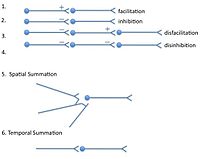Spatial summation

Spatial summation is like building a block tower. When you stack one block on top of another, you make the tower taller. But if you just stack one block on a table, it won't get any taller. The same thing happens in our brains when neurons (brain cells) receive signals from other neurons. When signals from many neurons are added together in one place, they can create a bigger signal that can make the neuron "fire" and send a signal of its own.
This is called spatial summation because it's like adding signals from different places in space. Imagine you have a bunch of blocks spread out on a table. Each block represents a signal from a different neuron. If you stack one block on top of another, you're adding their signals together in one place. If you keep adding blocks, you might eventually create a tower that's tall enough to make a neuron "fire" and send a signal of its own.
In the brain, this means that signals from different neurons can work together to create a stronger signal that can then pass to other neurons and keep the message going. So just like building a tower with blocks, spatial summation allows neurons to build up signals from different sources in order to create a bigger, stronger signal.
This is called spatial summation because it's like adding signals from different places in space. Imagine you have a bunch of blocks spread out on a table. Each block represents a signal from a different neuron. If you stack one block on top of another, you're adding their signals together in one place. If you keep adding blocks, you might eventually create a tower that's tall enough to make a neuron "fire" and send a signal of its own.
In the brain, this means that signals from different neurons can work together to create a stronger signal that can then pass to other neurons and keep the message going. So just like building a tower with blocks, spatial summation allows neurons to build up signals from different sources in order to create a bigger, stronger signal.
Related topics others have asked about:
